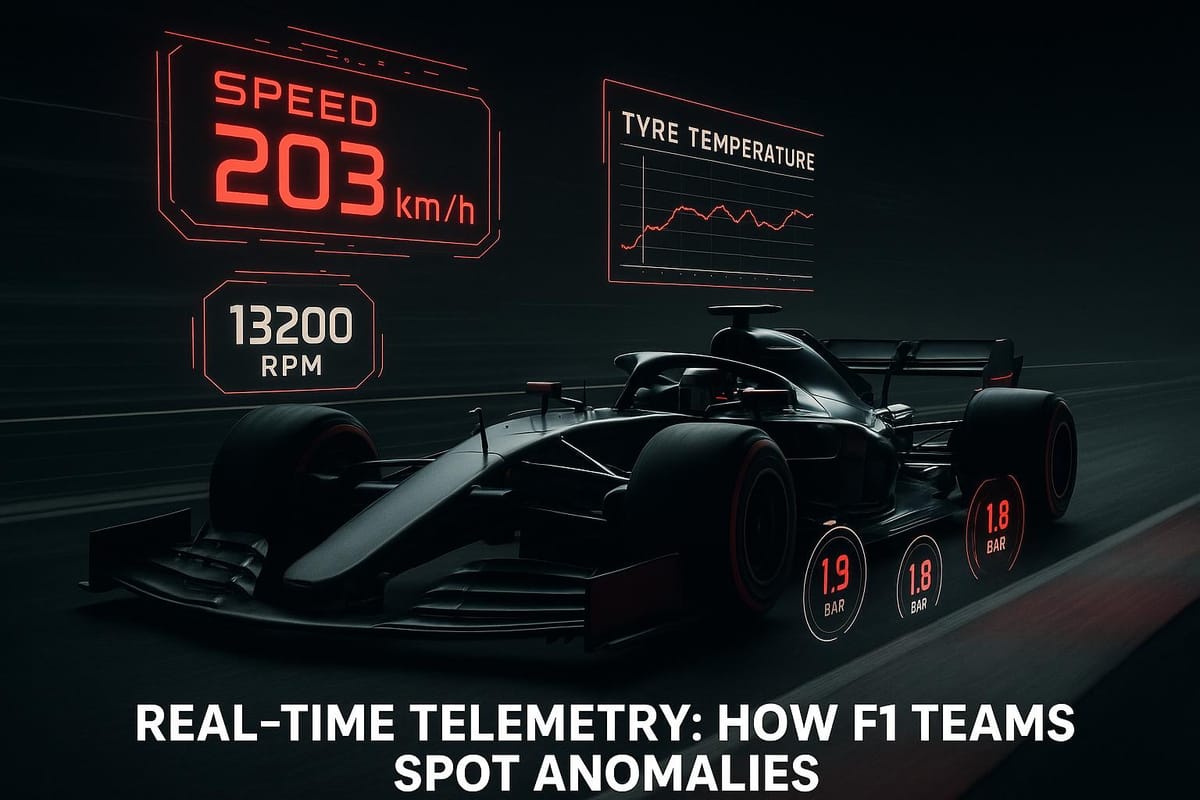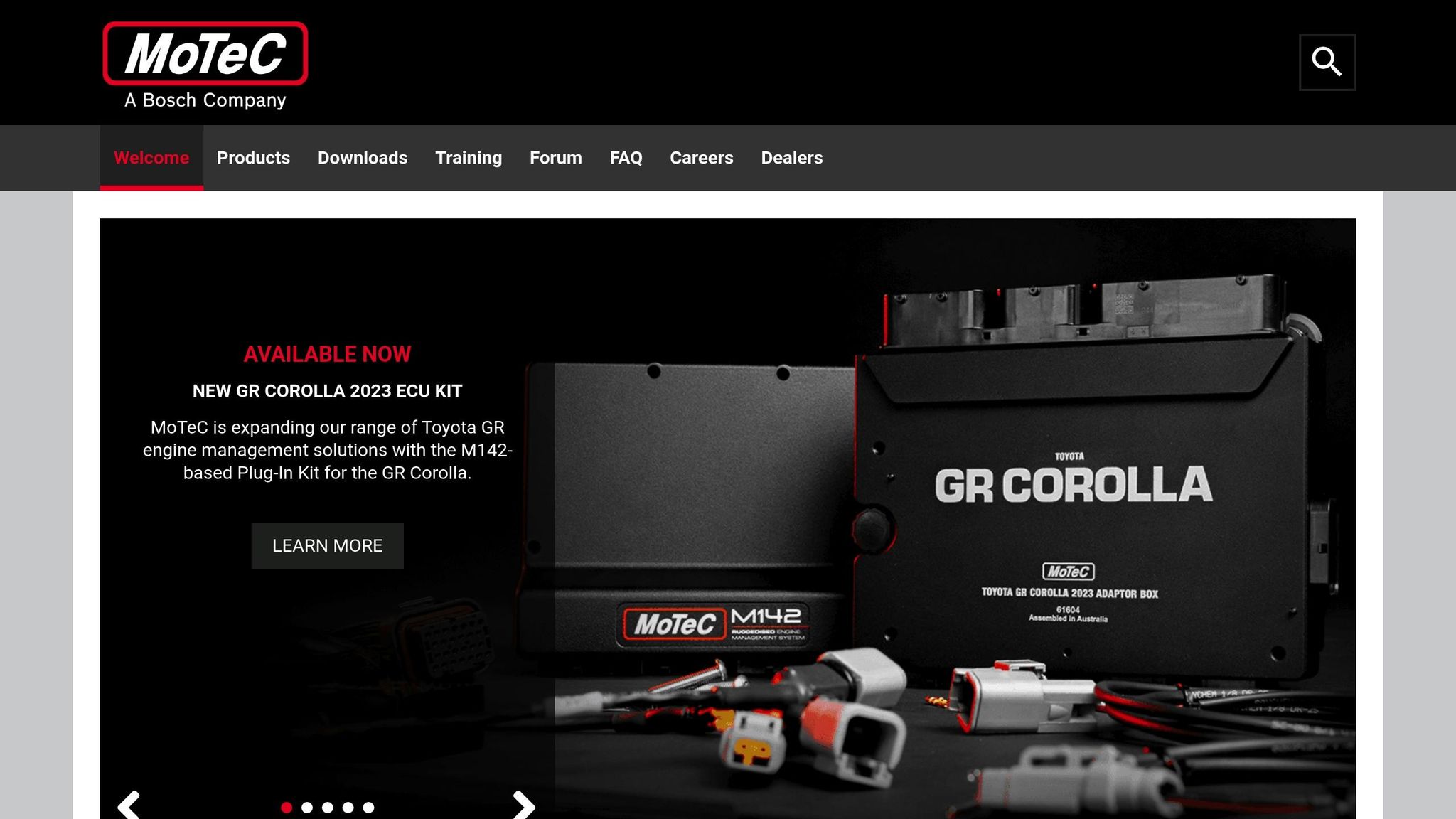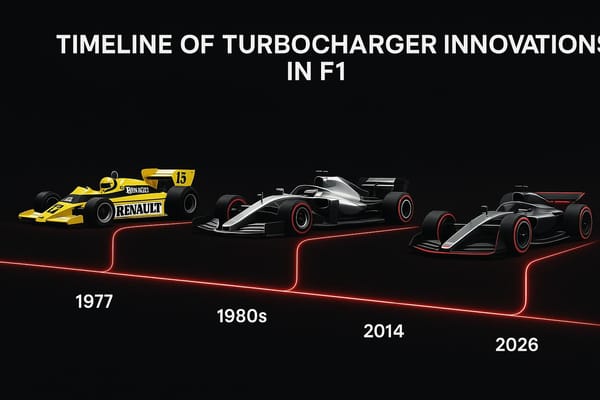Real-Time Telemetry: How F1 Teams Spot Anomalies
Explore how real-time telemetry revolutionizes F1 racing, enabling teams to optimize performance and prevent failures with advanced data analysis.

Formula 1 has transformed into a data-driven sport, with real-time telemetry at its core. This technology streams thousands of data points per second from cars to teams, enabling quick decisions to optimize performance and prevent failures. Here's what you need to know:
- What it is: Telemetry uses sensors to monitor metrics like tire pressure, engine performance, and fuel usage. Data is transmitted via secure channels to engineers.
- Why it matters: Teams use telemetry to adjust strategies mid-race, schedule pit stops, and detect mechanical issues early.
- How it works: Advanced systems, including machine learning, analyze data for anomalies such as irregular brake temperatures or fuel flow changes.
- Challenges: Managing the massive data flow requires powerful processing systems and secure communication networks.
Telemetry isn’t just about spotting problems - it shapes race strategies, ensures safety, and boosts performance. It’s a game-changer in motorsport.
Former F1 Data Engineer Explains Race Telemetry | MoTeC [#TECHTALK]

Key Components of F1 Telemetry Systems
Modern F1 telemetry is a sophisticated blend of sensors, real-time data transmission, and on-the-spot data analysis. Together, these elements form the backbone of how teams monitor car performance and address issues in real time.
On-Car Sensors and Data Collection
F1 cars are packed with sensors that capture a wide range of performance metrics. For instance, engine and powertrain sensors monitor vital aspects like oil and coolant temperatures, fuel flow rates, and turbocharger efficiency. These sensors operate at lightning speed, detecting even the smallest fluctuations.
Tire monitoring systems are some of the most advanced in motorsport. They track tire pressure, surface temperature, and how the tires deform under stress. This data is critical for fine-tuning tire strategies and spotting potential problems early.
Aerodynamic sensors measure key factors like airflow, downforce, and drag, offering insights into how these variables shift during a race. Suspension and chassis sensors, on the other hand, focus on forces acting on the car, such as brake temperatures and suspension movement. Together, these sensors deliver the raw data that teams rely on to make quick, informed decisions.
Data Transmission and Communication
Transmitting data from a car speeding around a track is no small feat. F1 teams rely on radio frequency systems that operate on secure, dedicated channels, often protected with encryption to keep the data safe.
Trackside infrastructure, like high-speed fiber-optic networks, ensures telemetry data is relayed without delay. In more remote or challenging locations, satellite communication provides a reliable backup, ensuring teams stay connected no matter where the race is held.
Team Infrastructure for Data Processing
Once the telemetry data reaches the team, it’s processed almost instantly at mission control centers and mobile units using powerful computing systems. This rapid analysis is crucial for making split-second decisions.
More and more, teams are turning to machine learning algorithms to identify patterns in the data. These systems can recognize normal operating conditions and flag unusual deviations that might signal a problem. Data visualization tools then transform the raw numbers into clear, actionable insights, enabling engineers and strategists to react quickly and adjust race strategies as needed. This seamless integration of technology and human expertise is what keeps F1 teams ahead of the curve.
How F1 Teams Detect Anomalies Using Telemetry
Every second, Formula 1 cars generate thousands of data points, creating a continuous stream of information. To stay ahead of potential issues, teams rely on advanced systems to flag deviations that could impact race performance. Understanding these anomalies is the first step in tackling them effectively.
What Are Anomalies in Telemetry Data?
Anomalies in F1 telemetry are deviations from the expected performance benchmarks. These deviations can signal anything from minor concerns to critical problems requiring immediate action. For example, a sudden drop in oil pressure, unexpected shifts in tire pressure, irregular brake temperatures, or changes in aerodynamic performance can all point to underlying issues. Even something as subtle as a small change in fuel consumption could hint at an engine problem waiting to escalate.
Methods for Detecting Anomalies
To identify these anomalies, F1 teams use a mix of cutting-edge technology and expert analysis. Here's how they do it:
- Threshold-based alerts: Teams set predefined limits based on historical data. When a parameter exceeds these limits, an alert is triggered, signaling a possible issue.
- Machine learning systems: By analyzing baseline patterns, machine learning algorithms can spot deviations that might go unnoticed with standard alerts, offering a more refined approach to anomaly detection.
- Predictive analytics: These tools analyze trends like component wear, temperature changes, and stress levels to forecast potential failures. This allows teams to schedule maintenance before a problem arises.
- Pattern recognition: By comparing current telemetry data to historical patterns, systems can flag similarities to past incidents - even when individual parameters appear normal. This helps catch intermittent or hard-to-diagnose problems.
- Real-time correlation analysis: This method examines how different data streams interact. For instance, a rise in brake temperatures alongside stable overall performance might suggest the car is compensating for an issue, such as tire degradation or aerodynamic imbalance.
These methods work together to provide a comprehensive view of the car's performance, helping teams detect and address problems before they become critical.
Case Studies: Preventing On-Track Failures
Real-world examples highlight the importance of these systems. Teams have identified early warning signs like unusual vibrations or irregular fuel flow, prompting preventive measures. By replacing components or performing precautionary maintenance, they’ve managed to avoid potentially race-ending incidents. These proactive steps not only ensure safety but also maintain the car’s competitive edge during races.
How Telemetry Shapes Race Strategy
In Formula 1, telemetry data does much more than just ensure cars run safely - it plays a pivotal role in shaping race strategies. By continuously analyzing streams of data, teams can make split-second decisions that often determine the outcome of a race.
Telemetry and Pit Stop Timing
Telemetry isn't just about spotting anomalies; it also fine-tunes race-day strategies, especially when it comes to pit stops. Timing a pit stop correctly can make or break a race, and telemetry provides the insights needed to get it right.
For instance, teams rely on telemetry to monitor tire wear in real time. Sensors track surface temperatures across various zones of a tire, revealing how evenly - or unevenly - the rubber is wearing. Pressure readings give clues about the tire's structural integrity, while grip levels indicate when performance starts to fade. When the data shows that tire efficiency is dropping below optimal levels, strategists can pinpoint the perfect lap for a pit stop.
Fuel flow data also plays a critical role. By analyzing consumption patterns, teams can predict how the car's weight will change as fuel burns off. A lighter car is faster, but balancing that speed advantage with the time lost during a pit stop is a delicate calculation. Telemetry helps teams strike the right balance.
Weather conditions add another layer of complexity. Telemetry systems incorporate data from track temperature sensors and atmospheric readings to predict how tire compounds will perform under changing conditions. If rain is on the horizon or track temperatures shift, teams can adjust strategies accordingly.
Driver Feedback and Real-Time Adjustments
Formula 1 cars are constantly sending data back to their teams, enabling real-time adjustments that enhance performance. This feedback loop helps drivers make critical tweaks during the race.
For hybrid F1 cars, telemetry provides updates on battery charge levels, energy recovery rates, and the best zones for deploying stored electrical energy. Drivers use this information, displayed on their steering wheels, to decide when to push for overtakes or defend their position.
As the race progresses, factors like decreasing fuel loads and shifting tire grip require changes in brake balance. Telemetry monitors brake temperatures, pressure distribution, and stopping distances, offering recommendations for adjustments that drivers can make directly through their controls.
Engine performance is another area where telemetry shines. By tracking temperatures, stress levels, and other parameters, teams can guide drivers on when to switch to higher power modes for aggressive racing or conserve engine life for future events. These in-the-moment adjustments work hand-in-hand with pre-race planning to maximize results.
Using Telemetry Data in Race Simulations
Telemetry's impact extends beyond the race itself - it’s a cornerstone of pre-race preparations. Teams use telemetry to power simulations that help refine strategies and prepare for every possible scenario.
Race simulations rely on telemetry from practice sessions, qualifying laps, and previous races to build highly accurate models. These simulations test various combinations of pit stop timings, tire strategies, and fuel loads. By analyzing these scenarios beforehand, teams can react swiftly during the race because they’ve already explored similar situations.
Driver training also benefits from telemetry-fed simulations. By recreating exact track conditions based on real data, simulators allow drivers to practice handling specific challenges they might face on race day. This preparation can make all the difference when quick decisions are required on the track.
Machine learning takes these simulations to the next level. By analyzing past race data, these algorithms improve prediction accuracy, helping teams make decisions based on likely outcomes rather than just historical trends. This blend of technology and telemetry gives teams a competitive edge in crafting race strategies.
Challenges in F1 Telemetry
Telemetry is the backbone of real-time decision-making in Formula 1, streaming vast amounts of data from every car on the track. But with this wealth of information comes significant challenges, especially when it comes to managing and processing the massive data flow during a race.
Handling Massive Data Streams
F1 cars generate an extraordinary amount of telemetry data, far beyond what standard systems are built to handle. The challenge lies not just in the precision of sensors or the speed of transmission but in dealing with the sheer volume of information. Teams must quickly filter, store, and retrieve both live and historical data to uncover insights that can drive split-second decisions - decisions that can make or break a race.
To tackle these hurdles, teams rely on high-performance computing and specialized software designed to handle complex telemetry streams. By continuously improving their data processing systems, they can better manage the overwhelming flow of information and fine-tune their strategies on race day. This ability to efficiently process data is a critical factor in staying competitive on the track.
Conclusion: The Impact of Telemetry on Formula 1

Telemetry has transformed Formula 1 from a sport driven by instinct to one dominated by data, where every millisecond counts. Today’s F1 cars are equipped with over 300 sensors, collectively generating up to 1 million data points per second and producing around 400 GB of data per car over a race weekend.
This shift has redefined the sport in several key ways. Teams now rely on telemetry to identify potential issues before they escalate, allowing for split-second decisions that can make or break a race. Safety has also improved, as telemetry provides early warnings for critical parameters, helping to prevent dangerous situations on the track.
With the integration of AI and machine learning, teams have moved from simply reacting to problems to proactively optimizing performance. This evolution has fundamentally changed how races are strategized and won.
Formula 1 also leads the way in adopting cutting-edge technology. From 5G networks and satellite-assisted telemetry to advanced cybersecurity, the sport continues to push boundaries. Yet, despite these advancements, the human element remains irreplaceable. Telemetry and AI enhance the skills of drivers and teams rather than overshadowing them.
As F1 continues to innovate, its focus on sustainability and advancements in telemetry will play a vital role in shaping the sport’s future. Real-time anomaly detection will only grow in importance, ensuring that the fastest cars on Earth operate at their absolute best.
FAQs
How do F1 teams use real-time telemetry to make better decisions during a race?
F1 teams depend on real-time telemetry to keep a close eye on vital metrics such as tire wear, fuel levels, engine performance, and track conditions. This steady flow of data enables engineers to spot potential problems, refine strategies, and relay important adjustments to drivers without delay.
Through detailed analysis of this information, teams can fine-tune pit stop timing, ensure tires perform at their best, and react swiftly to shifts in race dynamics. These data-driven insights provide a competitive edge, empowering teams to make decisions that can shape the outcome of a race.
How do F1 teams use machine learning to detect telemetry anomalies and improve car performance?
Machine learning plays a key role in Formula 1 by enabling teams to process and analyze enormous volumes of real-time telemetry data. This technology helps spot unusual patterns that could indicate technical issues or performance inconsistencies. By automating the detection of these anomalies, teams can act quickly to address potential problems, enhancing both safety and reliability during races.
Beyond troubleshooting, machine learning also improves race performance. It predicts crucial factors like tire wear and fuel efficiency under dynamic race conditions. With these insights, teams can make smarter, more informed strategic decisions, optimizing the car's performance and giving them a competitive edge on the track.
How do F1 teams manage and analyze real-time telemetry data during a race?
Managing telemetry data in real-time during a race is no small feat for F1 teams. The cars generate an enormous amount of information, and handling it comes with its own set of challenges - like processing vast data streams, reducing delays, and merging data from countless sensors and systems.
To tackle these hurdles, teams rely on high-speed data transmission systems combined with advanced analytics platforms. These tools sift through and process data almost instantly, enabling engineers to spot critical issues as they happen - whether it’s unexpected tire wear or a dip in engine performance. With the help of cutting-edge technology, teams can react swiftly, make smart calls on strategy, and fine-tune performance to stay ahead on the track.




